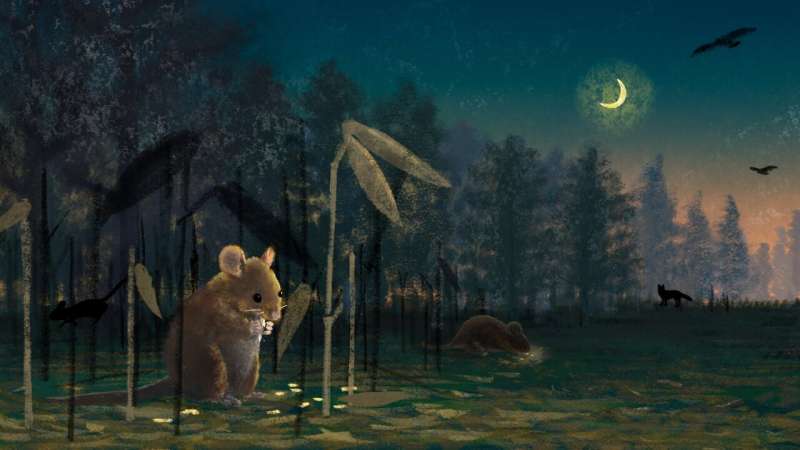This article has been reviewed according to Science X's editorial process and policies. Editors have highlighted the following attributes while ensuring the content's credibility:
fact-checked
peer-reviewed publication
trusted source
proofread
Study examines the relationship between mice and a plant that flowers once a century

Researchers at Nagoya University in Japan have revealed new insights into the interaction between mast seeding plants and the animals that eat their seeds. Hanami Suzuki and Professor Hisashi Kajimura examined the behavior of field mice using seeds from once-in-a-century flowering sasa bamboo plants in central Japan.
The researchers found that the seed use patterns of field mice differed by species (large Japanese field mouse Apodemus speciosus and small Japanese field mouse A. argenteus), the presence or absence of understory vegetation, forest tree species (broadleaf forest or coniferous forest), and season (summer or fall). Their findings underscore the importance of understanding the needs of both plants and animals to ensure the health of local ecosystems. They also overturn a previously held belief about how mice store seeds.
Dwarf bamboo (Sasa borealis) exhibits masting behavior in wide areas. Masting behavior means a plant collectively flowers and seeds at regular intervals to overwhelm predators and maximize pollination rates. Masting events are rare, however, with intervals up to 120 years. But when they occur, the resulting abundance of seeds in the forest provides easily available food for various animals, especially rodents such as field mice.
To understand more about the behavior of field mice during masting events, the researchers placed seeds in shallow mesh baskets to simulate mass flowering and seeding. They then used an automatic camera to record the foraging behavior of field mice in different forest environments and in different seasons.
Initially, as expected, some mice ate seeds they found on the spot. However, others would perform "dispersal behavior," carrying seeds away and burying them for later feeding. This is an example of a behavior called "removal and caching."
The two species of field mice also behaved differently. The large Japanese field mouse consumed the seeds where plants and bushes protected them from predators. They also carried the seeds from areas where they were more vulnerable, such as areas without vegetation. The small Japanese field mouse, meanwhile, was more likely to carry seeds to another location even when there was protective vegetation. The researchers suspect that the differences in mouse body size probably explain this behavior. In short, larger mice worry less about other rodents stealing their food.
Seasonality and tree species also appeared to affect how frequently the mice ate the seeds. The rodents were more likely to eat seeds immediately in summer than in fall, probably due to the availability of food. They were also more likely to consume seeds on the spot in coniferous forests than in broadleaf forests, again probably because of the availability of other food stores. Since alternative foods for later consumption, especially acorns, are more abundant in broadleaf forests, a mouse can afford to consume them right away.
Mice were more likely to immediately eat their food in broadleaf forests during the fall. This behavior plays an important role in ensuring that seeds spread throughout the forest.
According to Suzuki, "Forest-dwelling field mice play an important role in the distribution and renewal of trees because they act as seed dispersers that transport and store seeds. This suggests that we need to re-evaluate the relationship between the simultaneous seeding of S. borealis and field mice. It may also spread to food selection with other tree seeds and the prediction of forest renewal and vegetation succession connected to it."
Suzuki explained that "the simultaneous seeding of sasa species is known worldwide to cause large outbreaks of field mice, which are typical seed-eaters. It has been studied as a prominent example of the effects of plants on animals. As seed predators, the choices and behavior of mice, such as feeding or 'removal and caching," can lead to inhibition of certain plants or enhance their ability to regenerate. When I learned of this, I became really interested in field mice as an important species for the future of forest ecosystems."
"There have been many studies on the relationship between field mice and seeds," she continued.
"The established theory states that larger seeds, such as chestnuts and acorns, are subject to removal and caching, while smaller seeds are consumed more quickly. However, our results revealed that even much smaller seeds, such as those of Sasa borealils, that weigh as little as about 0.025 g per seed, are also a caching target of mice. Therefore, the dispersal and storage behavior of field mice for seeds as small as sassafras suggests that the established theory needs to be revised."
"Our experiments showed that field mice consider the surrounding environment and flexibly utilized Sasa seeds," Kajimura concludes. "Since this kind of behavior affects tree regeneration, as well as understory vegetation, our findings show the influence of mice on the creation of complexities of the forest ecosystem."
Professor Hisashi Kajimura (he, him) and doctoral student Hanami Suzuki (she, her) are researchers at the Graduate School of Bioagricultural Sciences at Nagoya University, Japan. Their findings were published in the journal Frontiers in Ecology and Evolution.
More information: Hanami Suzuki et al, Utilization of Sasa borealis seeds by Japanese field mouse: discovery of small-seed caching, Frontiers in Ecology and Evolution (2023). DOI: 10.3389/fevo.2023.1124393
Journal information: Frontiers in Ecology and Evolution
Provided by Nagoya University




















